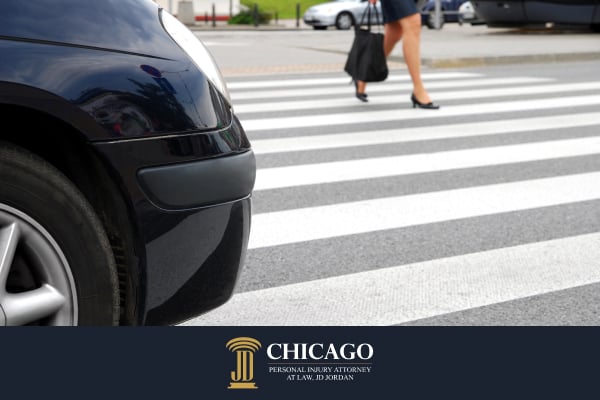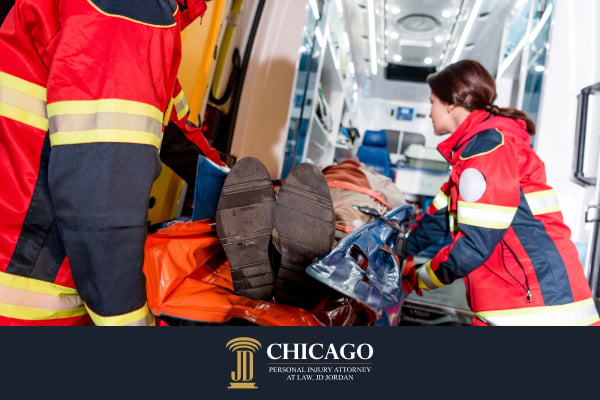



The team at Chicago Personal Injury Attorney at Law helps people hurt while walking on city streets and sidewalks. Our Chicago pedestrian accident lawyer always puts the needs of our clients first. Our pedestrian accident attorneys work hard to get you money for medical bills, lost wages, and pain.
Learn more about severe injuries in pedestrian accidents below. Then, contact our personal injury lawyer to schedule a free case consultation.
Drivers who hit pedestrians often try to blame the victim for the crash. They claim you "came out of nowhere" or "weren't using a crosswalk" to avoid paying for your injuries. Our pedestrian accident lawyer knows how to fight back against these unfair tactics with evidence that shows what really happened.
Insurance companies try to settle pedestrian cases quickly and cheaply before victims understand their rights. They know these injuries are often severe and may require years of care. We handle all talks with the insurance company, so you don't say anything that hurts your case.
Chicago has several dangerous intersections where pedestrian accidents happen more often. Places like Ashland and 79th, Stony Island and 79th, and Western and Peterson see multiple pedestrian crashes each year. These busy intersections often have fast traffic, poor lighting, or confusing crosswalks that put people at risk.
The city has tried to improve some problem areas with better signals and marked crosswalks. Still, many dangerous spots remain, especially in neighborhoods with lots of foot traffic. Our legal team tracks accident patterns across Chicago to help show that certain locations have known dangers that drivers should watch for.
Darkness makes pedestrian crashes much more likely, with most fatal accidents happening after sunset. Drivers often can't see people walking at night, especially when they wear dark clothing. The risk gets even worse when street lights are broken or missing on major roads.
Speed plays a huge role in how bad these crashes become. A pedestrian hit at 20 mph has a 90% chance of survival, but that drops to just 50% at 30 mph. Many drivers exceed speed limits at night when traffic is lighter, not realizing how this puts pedestrians in serious danger. Our firm works with accident reconstruction experts who can prove that speeding contributes to crash severity.


Illinois law requires drivers to exercise special care around pedestrians, especially in crosswalks and school zones. Drivers must yield to pedestrians in both marked and unmarked crosswalks at intersections. They must also stop when other vehicles have stopped for pedestrians, even if they can't see the person crossing.
Even when pedestrians cross outside crosswalks, drivers still have a duty to avoid hitting them if possible. The law recognizes that in a crash between a person and a vehicle, the person will always suffer more harm. This creates a higher responsibility for drivers to watch for people walking near roads and drive carefully around them.
To win your pedestrian accident case, we must show that the driver failed to use reasonable care and directly caused your injuries. We gather evidence from police reports, witness statements, traffic cameras, and sometimes accident reconstruction experts. This evidence helps establish exactly how the crash occurred and who bears responsibility.
We also need to document all your injuries and how they affect your life. Medical records, doctor testimony, and your own account of how injuries impact your daily activities all help prove your damages. Photos of visible injuries, videos of your physical limitations, and statements from friends or family about your changed abilities strengthen your claim for fair compensation.

The value of your pedestrian accident case hinges on several key factors, including the degree of your injuries, your medical costs, and your lost income. More serious injuries that cause permanent disability or require long-term care typically result in larger settlements. We calculate both your current costs and future needs to ensure you don't settle for too little.
Non-economic damages like pain and suffering often make up a significant portion of pedestrian accident settlements. The physical pain, emotional distress, and lost quality of life caused by your injuries deserve substantial compensation. We help juries and insurance adjusters understand how your injuries affect you every day, not just in medical bills and lost wages.
You can still recover damages even if you weren't in a crosswalk when hit. Illinois uses "comparative negligence" rules, meaning you can still get compensation as long as you were less than 50% at fault for the accident.
You can demand compensation for medical expenses, lost wages, physical pain, emotional distress, and permanent disability. In cases involving reckless drivers, you might also qualify for punitive damages meant to punish especially bad behavior.
Yes, close family members can file wrongful death claims when pedestrians die in accidents. These claims can recover burial costs, lost financial support, and compensation for the family's grief and loss of companionship.
Hit-and-run victims still have options, including claims through their own insurance policies. We can help identify the driver through security camera footage, witness accounts, and police investigations.
Illinois follows a modified comparative negligence rule that slashes your compensation by your degree of fault. For example, if you're found 20% responsible and have $100,000 in damages, you would receive $80,000.

At Chicago Personal Injury Attorney at Law, we help injured pedestrians recover the damages they deserve. Our experienced team offers free consultations to discuss your case and explain your options. Contact us today to speak with a pedestrian accident lawyer who will fight for your rights.
